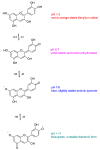Anthocyanins: A Comprehensive Review of Their Chemical Properties and Health Effects on Cardiovascular and Neurodegenerative Diseases
- PMID: 32825684
- PMCID: PMC7504512
- DOI: 10.3390/molecules25173809
Anthocyanins: A Comprehensive Review of Their Chemical Properties and Health Effects on Cardiovascular and Neurodegenerative Diseases
Abstract
Anthocyanins are a class of water-soluble flavonoids widely present in fruits and vegetables. Dietary sources of anthocyanins include red and purple berries, grapes, apples, plums, cabbage, or foods containing high levels of natural colorants. Cyanidin, delphinidin, malvidin, peonidin, petunidin, and pelargonidin are the six common anthocyanidins. Following consumption, anthocyanin, absorption occurs along the gastrointestinal tract, the distal lower bowel being the place where most of the absorption and metabolism occurs. In the intestine, anthocyanins first undergo extensive microbial catabolism followed by absorption and human phase II metabolism. This produces hybrid microbial-human metabolites which are absorbed and subsequently increase the bioavailability of anthocyanins. Health benefits of anthocyanins have been widely described, especially in the prevention of diseases associated with oxidative stress, such as cardiovascular and neurodegenerative diseases. Furthermore, recent evidence suggests that health-promoting effects attributed to anthocyanins may also be related to modulation of gut microbiota. In this paper we attempt to provide a comprehensive view of the state-of-the-art literature on anthocyanins, summarizing recent findings on their chemistry, biosynthesis, nutritional value and on their effects on human health.
Keywords: anthocyanidins; anthocyanins; antioxidants; bioavailability; biological activity; biosynthesis; colorants.
Conflict of interest statement
The authors declare no conflict of interest.
Figures











References
-
- Castañeda-Ovando A., de Lourdes Pacheco-Hernández M., Páez-Hernández M.E., Rodríguez J.A., Galán-Vidal C.A. Chemical studies of anthocyanins: A review. Food Chem. 2009;113:859–871.
-
- Qiu Z., Wang X., Gao J., Guo Y., Huang Z., Du Y. The tomato hoffman’s anthocyaninless gene encodes a bHLH transcription factor involved in anthocyanin biosynthesis that is developmentally regulated and induced by low temperatures. PLoS ONE. 2016;11:e0151067. doi: 10.1371/journal.pone.0151067. - DOI - PMC - PubMed
Publication types
MeSH terms
Substances
LinkOut - more resources
Full Text Sources
Medical

